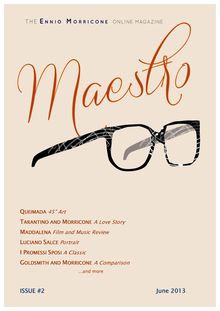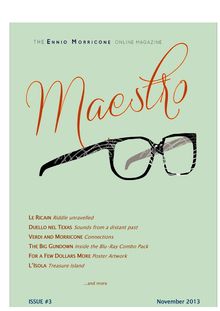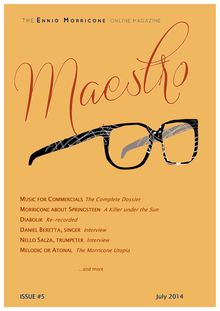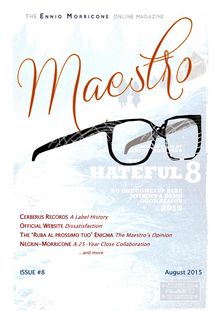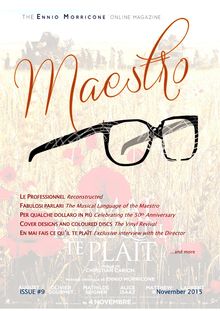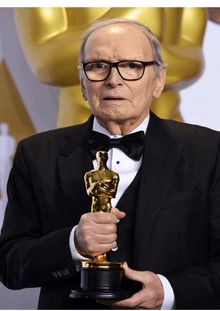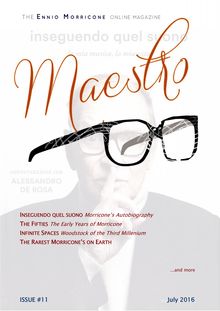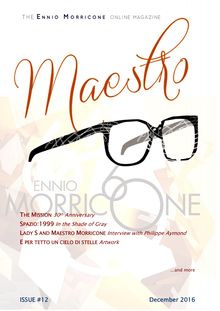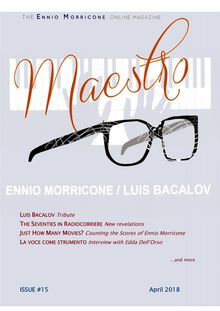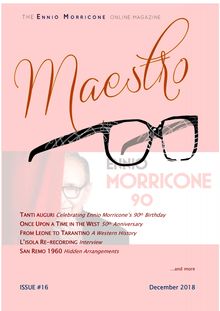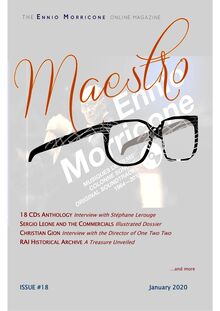-
 Univers
Univers
-
 Ebooks
Ebooks
-
 Livres audio
Livres audio
-
 Presse
Presse
-
 Podcasts
Podcasts
-
 BD
BD
-
 Documents
Documents
-
- Cours
- Révisions
- Ressources pédagogiques
- Sciences de l’éducation
- Manuels scolaires
- Langues
- Travaux de classe
- Annales de BEP
- Etudes supérieures
- Maternelle et primaire
- Fiches de lecture
- Orientation scolaire
- Méthodologie
- Corrigés de devoir
- Annales d’examens et concours
- Annales du bac
- Annales du brevet
- Rapports de stage
La lecture à portée de main
60 pages
English
Le téléchargement nécessite un accès à la bibliothèque YouScribe
Tout savoir sur nos offres
Tout savoir sur nos offres
60 pages
English
Le téléchargement nécessite un accès à la bibliothèque YouScribe
Tout savoir sur nos offres
Tout savoir sur nos offres

Description
PREFACE - Rebirth - Didier Thunus (3,4); NEWS: In breve, Old News, Web News - Didier Thunus; CD News - Patrick Bouster (5-15); IN MEMORIAM - R.I.P. Don Trunick, The Godfather of the Morricone Fans (16-20); INTERVIEW - L’enfant du Sahara: Reusing music with discernment - Patrick Bouster (21-26); DOSSIER - Forgotten Works Society: Exploring the SIAE Database, Part 1 of 2 - Didier Thunus (27-36); ARTWORK - A Fistful of Dynamite - Steven Dixon (37-41); INTERVIEW - Dougie Meakin: Yesterday - Didier Thunus and Frédéric Durand (42-45); VINTAGE - Dick Kallman plays Ennio Morricone - Steven Dixon (46,47); TECHNICALITIES - Sahara: Track Correspondence - Didier Thunus and Patrick Bouster (47,48); EXPERIMENT - The American Symphonies, First try-out: Sahara - Patrick Bouster (49,50); INTERVIEW - Paolo Zampini: Il Maestro del flauto, il flauto del Maestro - Patrick Bouster et al. - (51-59)
Sujets
Informations
| Publié par | didier_thunus |
| Publié le | 02 septembre 2015 |
| Nombre de lectures | 42 |
| Licence : |
En savoir + Paternité, pas d'utilisation commerciale, partage des conditions initiales à l'identique
|
| Langue | English |
| Poids de l'ouvrage | 6 Mo |
Extrait
This issue is dedicated to the memory of
SAHARAAn American Symphony
DONTRUNICK
L’ENFANT DUSAHARAInterview with the Director
THESIAEDATABASEAnother treasure island
PAOLOZAMPINIFlute player
DOUGIEMEAKINInterview ...and more
ISSUE #7
April 2015
MAESTRO–THEENNIOMORRICONEONLINEMAGAZINE
ISSUE#7
APRIL2015
Table of ContentsPreface ........................................................................................................................................ 3 In breve / Old News / Web News............................................................................................... 5 R.I.P. Don Trunick – The Godfather of the Morricone Fans ................................................... 16 L’enfant du Sahara: Reusing music with discernment............................................................. 21 Forgotten Works Society: Exploring the SIAE Database – Part 1 of 2 ................................... 27 A Fistful of Dynamite: Artwork............................................................................................... 37 Dougie Meakin – Yesterday..................................................................................................... 42 Dick Kallman plays Ennio Morricone ..................................................................................... 46 Sahara – Track Correspondence............................................................................................... 47 The American Symphonies – First try-out: Sahara .................................................................. 49 Paolo Zampini: Il Maestro del flauto, il flauto del Maestro ..................................................... 51
License for all articles:CreativeCommons Cette œuvre est mise à disposition selon les termes de la Licence Creative Commons Attribution - Pas d’Utilisation Commerciale - Partage dans les Mêmes Conditions 2.0 Belgique PUBLICATION PÉRIODIQUE D'ÉTUDE ET DE CRITIQUE DANS LE DOMAINE ARTISTIQUE.LES TEXTES SONT PUBLIÉS SOUS LA RESPONSABILITÉ DE LEURS AUTEURS,QUI EN CONSERVENT LA PROPRIÉTÉ DES DROITS D'AUTEUR ET INTELLECTUELS. All the articles are of purely informative nature. We do not own the copyright of the images included in this document or of the audio clips accessible from it. All the rights on the images and the music are the property of their respective owners. Chief editors:Patrick Bouster and Didier Thunus Front cover design:Valeria Magyar Front cover inlay:Anne-Catherine Mortiaux Back cover drawing:Amsel
2
MAESTRO–THEENNIOMORRICONEONLINEMAGAZINE
ISSUE#7
—————PREFACE—————
Rebirth
by Didier Thunus
APRIL2015
2015 couldn’t have started better. After hearing of Ennio’s regain of form end of last year, we now not only see him conducting concerts again, but also writing a full new score to a feature film. This excellent piece of news was totally unexpected. Even if we were hoping the Maestro to start writing and recording music again, we didn’t expect much more than a couple of TV-films, and maybe a Tornatore movie. But withEn mai, fais ce qu’il te plaît by Christian Carion, our Maestro took us by surprise.
And cherry on the cake, it is a French movie, to the delight of our French friends. They were somewhat embarrassed when asked what was the last French movie scored by Morricone. In order to not admit that it was actuallyLa cage aux folles 3(1985) – not exactly a highlight – they were pretending thatFrantic (Roman Polanski, 1988) orVatelJoffé, 2000) (Roland were French movies, which was only partially true since the directors were not French and the production was international. At best they could get away with the fact that he composed one theme for the short moviePlay the Game(Stéphane Barbato, 2005), or that he wrote a score – an unused one – forUn crime (Manuel Pradal, 2006), but that wasn’t really convincing, was it? None of this will be necessary anymore: they now have their French film, a real one and we are all extremely happy about this. A great way to extend his already impressive list of French movies after masterpieces such asLe clan des Siciliens,Sans mobile apparent,Le trio infernal,Le secret, and many more.
And then the tour started on February 1, in Amsterdam. The programme was disappointing, because it was just a collection of the usual suites – nothing new, in spite of what Ennio had announced in his “comeback” video interview. Besides, Dulce Pontes had to postpone her participation because of an injury. So basically, it’s justLa vita e la leggenda,Fogli sparsi, the Leone suite,Chi mai-Cinema Paradiso-Malèna,Cinema dell’impegno and theMissionsuite. I was lucky enough to attend the second concert of the tour, in Brussels. Even twice lucky because I was able to shake hands with the Maestro backstage before the concert. Just a brief moment, because I didn’t want to disturb him and, even if he was polite and smiling, obviously he didn’t want to be disturbed either. His son Giovanni, who is the director for the images projected on the two large screens, was our translator. I asked Ennio if he knew my website, to which he said no – so it wasn’t my glory day after all. But, for my consolation, his gesture when he said no was like saying “damn no, I don’t know any website”. Note that 1 Nicola Schittone told me he had talked about chimai.com to Ennio and his wife Maria, and they had shown great interest. So go figure...
He still moves with ease but conducts the orchestra sitting, which doesn’t seem to be a problem for the musicians though. He has been doing that in the studio for many years already, after all. His glance is not as sharp as it used to be, but what can we expect? He is 86 and had 1 Nicola has contributed to Maestro #4 (pp.34-37)
3
MAESTRO–THEENNIOMORRICONEONLINEMAGAZINE
ISSUE#7
APRIL2015
a very bad year. He conducts the Czech National Symphony Orchestra accompanied by 3 choruses (2 Hungarian and 1 Rumanian). Almost 200 persons on stage. Susanna Rigacci is the usual and reliable soprano, with soloists Nanni Civitenga (bass guitar), Rocco Zifarelli (guitars), Massimo D’Agostino (drums) and Leandro Piccioni (piano and keyboards), the latter replacing Gilda Buttà. The only difference I could hear in the arrangements was inOn Earth as it is in Heaven: the insertion of theGabriel’s Oboetheme inside the complex orchestration was played by the organ this time, which makes it much more audible than when played by brass as it is usually the case.
It was also a special event for me because it was the first time my two children (11 and 8) came along. They loved it! The crowd was amazing – more than 10,000 people, the sound was impeccable, after a necessary tuning by faithful sound engineer Fabio Venturi. The video projection still requires some adjustment because it was always late catching the right soloist, and the titles were always wrong, late or even absent. But no doubt that with Giovanni at the controls, this will all be resolved after a couple of concerts. The booklet that accompanies the concert is an impressive 53-page thick book full of images, interviews and biographies, with multilingual inserts. Quite a nice object, but with the usual mistakes in the filmography: the first year already has 3 mistakes out of 4 films (theVerro /Vicino al cielhas been riddle solved by fans long ago, andAlla scoperta dell’Americais from 1977, not 1961 as stated); the last years list all the movies which reuse Ennio’s music (this can’t just be a question of 2 bad memory anymore: it was only a couple of years ago!).
But there he is, touring the continent like a rock star. He has about 30 dates in total, all in Europe, between February and September. More dates will be announced soon. There is still a lot of energy in this little man, and a lot of pleasure to be expected by the fans.
Talking to his entourage, I can now tell you that there is a plan for an official forum again. So let’s not lose hope. The official website should be improved as well.
Apart from these great news, this new issue of Maestro will bring you in many different areas of the Maestro’s work, with exclusive interviews and revelations about his filmography. For some reason, the desert of the Sahara will be very present, not only because of the recent expanded edition of Sahara by Quartet, but also because of Patrick’s articles aboutL’enfant du Saharaand about Paolo Zampini. It’s already 2 years now that the fanzine exists. 7 issues have been published, about 400 pages in total. 332 persons have downloaded at least one issue. 128 have downloaded all issues – this is really the core gang. And since issue #5, 200 persons download an issue before the next one is published. We hope that reading it gives you as much pleasure as we have preparing it.
2 There were also other items on sale: cups, T-shirts, the CD/book “Morricone Awards” (seemingly different from the one of 2007 with the same cover image – to be checked), etc.
4
MAESTRO–THEENNIOMORRICONEONLINEMAGAZINE
ISSUE#7
—————NEWS—————
by Didier Thunus(except where noted)
In breve
APRIL2015
En mai, fais ce qu’il te plaît The best news of the period is, by far, the fact that Ennio Morricone has written a completely new original score for a movie. It is a French film, called En mai, fais ce qu’il te plaît (“In May, do whatever you like”). The title comes from a French maxim which says that in April, you shouldn’t take off any cloth, in reference to the weather that can still be chilly, whereas in May, you do as you like. Quite a “light” title for a movie with a “heavy” plot, emotionally speaking. It takes place in France in May 1940, at the beginning of WWII, when a lot of French people are fleeing in front of the German invasion. It is a road movie of a German who had escaped to France before the war and is now looking for his son. This assignment was announced in January by the music publisher Noodles Supervision, on 3 their website and Facebook page . The movie is directed by Christian Carion, already credited for a few movies with a good reputation, usually using Philippe Rombi for the music. The cast is international, with German actor August Diehl (Inglourious Basterds,Night Train to Lisbon), Olivier Gourmet from Belgium (most of the films of the Dardenne brothers), French actress Mathilde Seigner (who had played for Carion already inUne hirondelle a fait le printemps), WelshmanMatthew Rhys... The music was recorded last January at the Forum Music Village, with the Roma Sinfonietta. The working title of the movie seems to have beenEsodo, because this is the title we can read on the cover of Ennio’s score on paper, on one of the pictures. The movie will be released in November this year. Let’s hope for a CD around that period as well! We know already that there will be a second feature film for Morricone this year: Tornatore’s 4 La corrispondenza., whose filming has just started
3 http://www.noodles-supervision.com/portfolio/en-mai-fais-ce-quil-te-plait/https://www.facebook.com/NoodlesSupervision4 See/2ts5/01ylstare//sweefililgnn/hsnsa.it/e://www.athpt3-96e97d5_eivom-wen-ming-filtartto-sro-enrta/9ot301/
5
MAESTRO–THEENNIOMORRICONEONLINEMAGAZINE
ISSUE#7
APRIL2015
Negrin without Morricone Alberto Negrin directed two movies last year, which were both broadcast on RaiUno in late 2014:Qualunque cosa succedaandUn mondo nuovo. We knew there was very little chance to see Ennio Morricone write new music for these movies, even though he has worked on all Negrin movies sinceSecret of the Sahara in 1987 (except forUna questione privata in 1991, scored by Nicola Piovani). A total of 13 movies – by far Ennio’s richest collaboration from the past decades, and ranging amongst his most valuable achievements. At best, we could have hoped to see Negrin reuse existing music, as he did forI 57 giorniin 2012, when RAI didn’t have enough money to pay a composer. But the truth is that Negrin chose this time to work a different composer, even two of them, as Qualunque cosa succeda was scored by Fabrizio Siciliano, andUn mondo nuovoby Martino Palmitessa, unknown names in the film music field, at least to me. Adding insult to injury, RAI Trade has released the score to Qualunque cosa succeda. Do they even know they still have the recordings of 3 major Morricone scores in their vaults, waiting to be released? This includes Negrin’s ownMi ricordo Anna FrankandL’isola.The music is quite good, very much in the mood of the Morricone scores for Negrin. It’s as if the sole instructions of Negrin to Siciliano had been a pack of CDs fromIl cuore nel pozzo,Perlascaor L’ultimo dei Corleonesi. This was of course a disappointment for us, but let’s still wish a lot of success to Siciliano and Palmitessa. We can be sure though, that if Morricone is available for the next Negrin movie, the director will not hesitate for one second.Eastwood and Morricone: Reunion The end titles music from Eastwood’s latest movie is a Morricone piece. The much debateAmerican Sniper indeed made use of Morricone’sThe Funeral, a piece written forIl ritorno di Ringo in 1965. It is actually an adaptation of an Italian cavalry bugle call namedIl silenzio, made popular by trumpeter Nini Rosso in 1964, which Morricone had already adapted in a version more faithful to Rosso’s, for the trumpet of Michele Lacerenza (RCA PM45-3295). For...Ringo, Morricone wrote 2 versions of it: one with lyrics is calledLa gente miaand is sung by Maurizio Graf, the other one is theFuneralequestion, an instrumental version. Eastwood in clearly used it as a patriot piece, thereby diverting it from its Italian origin. The movie has very little music (and even no official soundtrack release), so this piece is clearly put in the forefront. Hard to say how such an Italian piece could end up in a modern
ec09-4d6e-bd22-82c9c629cf17.html
6
MAESTRO–THEENNIOMORRICONEONLINEMAGAZINE
ISSUE#7
APRIL2015
American blockbuster – maybe it is due to the kinship of Eastwood with the Italian western, but I don’t think he was ever a collector of Morricone’s albums. Listen to the piece here:https://www.youtube.com/watch?v=0bzNVVMQhfg.
New Releases A Quiet Place in the Country The LP ofUn tranquillo posto di campagnathat Morricone had in mind in 1968 has finally been released, 47 years later! It had remained at the state of a project because of the bad box-office score of the movie and of its very disconcerting nature. Now, with the revival of the good old vinyl LP, it finally found a publisher, namely the US-based Roundtable. Its contents had already been released by GDM on CD in the exact same form (GDM Club 7088, 2010), but with no track titles – except for the repetition of the film title with numbering. Before that, Saimel had released a completely different programme, much longer and approved by the Maestro (Saimel 3994710, 2003). Paradoxically, the new LP uses track titles which are the same as on the Saimel edition, but for different cues! When preparing the LP master back in 1968, Morricone had most likely made those titles available to the publisher. It looks as though GDM didn’t have access to them (or wasn’t allowed to use them), whereas Saimel was able to see them but didn’t know to which tracks they corresponded. Adding to this the fact that the last track on the Saimel CD was a collage of 9 tracks collectively calledSuite, the movie now presents a very complex lemma. The advantage of the shorter LP programme used by GDM and by Roundtable, is that it is in stereo. The score is for half composed by Morricone and conducted by Nicolai, and for the other half improvised by the Gruppo Nuova Consonanza. Saimel explicitly credits the wholeSuiteto the Gruppo. However, the first three parts of thisSuiteare clearly different from the rest, most likely not improvised and far from the Gruppo’s style. A wild guess would be that they were composed by the Maestro and conducted by Nicolai, but played by the Gruppo (maybe like it happened again 3 years later forGli occhi freddi della paura). The new LP doesn’t shed a new light on this, crediting collectively the composer, conductor and the Gruppo for the whole score. Amazingly enough, the movie doesn’t contain much of the released material, making use of additional, unreleased, improvised music. Other Releases GDM continues its series of double CDs, through monthly batches, useful for those who didn’t buy these expanded editions.Faccia a faccia - Senza movente01005) is (IMR especially interesting for the first film because it even contains the track (called suite) lately added on the Verita Note CD. TheSenza moventeCD (Sans mobile apparent) is complete too and respects the original soundtrack as it logically removed tracks fromLa donna invisibileandUna lucertola con la pelle di donnawhich were present on initial releases of that score.
7
MAESTRO–THEENNIOMORRICONEONLINEMAGAZINE
ISSUE#7
APRIL2015
The next double CD set (IMR 01206) reissuesLe pistole non discutono(Bullets Don’t Argue) coupled withL’avventuriero(The Rover), again in its latest form, which is probably not complete though. There is also a third CD (one release per month) dedicated to L’istruttoria è chiusa, dimentichi!andIl diavolo nel cervello (IMR 01407). The latter is now very famous, thanks to its many issues. But we cannot say it is complete even today:Atlantis, published on a library album back in 1978 is missing, probably for a question of rights. The latest double CD announced isIl fiore delle mille e una notte/La cuginaIMR (GDM 01608), complete with 24 + 15 tracks.
The phenomenon of vinyl LP doesn’t stop! See the recent publications: an EP ofFor a Few Dollars More (AMS 8016158308242) featuring the old 8 tracks program,Un tranquillo posto di campagnaRoundtable ROMA (The 101LP), with same content as the 2010 GDM CD (see above), “Eroina” by Nuova Consonanza (Cometa HOL 075),I crudeli as complete as the lastest CD (Cherry Red CASA 15LP),Escalation with same content as the original LP (Dagored RED 214LP),Spasmoas complete as the latest CD with 2 different covers (RED X0000216LP and Y000216LP),Il Maestro e Margherita(AMS GDMLP6701),Vamos a matar Compañeros (AMS GDMLP6702) and finallyIl sorriso del grande tentatore(ROMA103LP), containing 8 tracks, i.e. 2 tracks more than the original Beat LP, but the expanded Beat CD has those ones and many more.
Returning to the CDs, Rambling records reissuedIl giro del mondo degli innamorati di Peynet, with the same content as the previous GDM and Rambling editions of 2008. The Volcano edition (2000) is more complete in the sense that it missed only 3 tracks (the 2 songs among them) while the other main editions of 2008 and 2015 are missing 7 tracks but contain the 2 songs. Hoping everything is clear, we can just regret that a malediction seems to make impossible a complete edition from this soundtrack.
This would have been very little news without the Quartet Records edition ofSaharain a 2-CD set (QR 180) with all the music. The pure unreleased tracks so far can appear to be not so important with 11 minutes, but not many people had all the previous editions! Indeed the American and European LPs (of different contents) and the Intrada CD from 1992 were all necessary to aggregate all the material. Furthermore, it was very difficult to check the music details within these editions (and especially the suites), as you can see in the small article in this issue (p.47). So the Quartet edition puts brilliantly to the light, with a restored sound, all the cues in a new way, giving justice to the music and respecting the original titles. One minor thing: the back cover mentions the track
8
MAESTRO–THEENNIOMORRICONEONLINEMAGAZINE
ISSUE#7
APRIL2015
titles in so small characters that one needs a magnifying lens to read them. Don’t forget that many collectors are over 40-45 years old! At last, the presentation in two CDs is clearly justified here because all the music, including the alternate takes recorded only for the disc and the song, couldn’t all fit on one CD. The whole makes therefore a fair exception where the second CD provides something more than just the LP appearance.
Upcoming Release (?) Cometa briefly announced on its website the preparation of theE per tetto un cielo di stelleCD. The Roman label seemed to have stopped its nice series of expanded Morricone CDs which they released between 2010 and 2012, sometimes in collaboration with other labels such as Heristal, Mask or Legend. They still have a couple of interesting scores in their vaults though, likeThrilling, Autostop rosso sangue orViolenza quinto potere, so it’s nice to see them doing some Morricone again, even though not much can be expected from this specific release, which has already been expanded by Hexacord in 2002. Note that the announcement has now been removed, which is not a good sign.
Flatlandia
Old News
P.B.
Michele Emmer’s animation movie Flatlandia of 1982, based on Edwin Abbott’s vision of a two-dimensional world, has been made available on 5 youtube with a clear link to Morricone by the person who posted the film. However, no mention of his name appears in the film credits, where other composers are credited: Erik Satie and Darius Milhaud, including the titles from the pieces which were used in the film. Listening to the music, the pieces from Satie and Milhaud are not easily recognizable, but they probably make up the bulk of the music in simplified arrangements for synths. We also recognize pre-existing music by Morricone, fromIl gatto(Quartetto tiberini) andQuesta specie d’amore(La terra del padre) – so his name should definitely have been credited alongside the two French composers. But most importantly, there are also at least two unknown pieces which sound like genuine compositions by the Maestro. This is confirmed by the SIAE database (discussed in detail later in this issue), which has an entry calledMUSICHE PER FLATLANDIA, credited to Morricone. No doubt is allowed anymore.
Michele Emmer, son of Luciano Emmer (Giotto), is also the director of another documentary to which Morricone’s name is associated:The Fantastic World of M.C. EscherIt (1980).
5 https://www.youtube.com/watch?v=A7DIhigATpI
9
MAESTRO–THEENNIOMORRICONEONLINEMAGAZINE
ISSUE#7
APRIL2015
also contains a couple of Morricone-sounding cues. However, nothing was found about it in the SIAE database.
Le femmine puntigliose
Information about a seldom discussed 6 entry listed in the EMM , calledLe femmine puntiglioseno other info, with 7 has been located on the internet . It corresponds to a theatre play of 1978 directed by Giuseppe Patroni Griffi, with indeed a Morricone credit. It is based on th Carlo Goldoni’s 18 century play of the same title, and stars Lina Sastri, Elio Pandolfi and Mariano Rigillo. It was played a couple of times in January 1979 in Rome.
The music of Morricone for theatre plays is probably the least known field of his repertoire, even though it now counts almost 20 entries. Apart fromLa fidanzata del bersaglierea couple of early songs, none of his and output for this genre has ever been released. Added to the fact that these projects are typically very localized, too little information about them circulates in the media and on the internet.
Trio Chitarristico Italiano The Trio Chitarristico Italiano, made up of Alfonso Borghese, Roberto Frosali and Vincenzo Saldarelli, is the only Italian guitar trio that secured a stable activity since the 1970’s up until today. Around 1988, Saldarelli invited Morricone to seminars at the Istitutto Superiore di Studi Musicali of Modena. That’s where Morricone’s interest in the Trio was born. In 2001, the composer sent them three pieces he had written especially for them:Un raga...?,Sulla sesta corda, andInquinamento progressivo. The Trio finally decided to record them in 2010, as part of recordings for a DVD produced by Guitar Media Collection. These pieces, previously known asTre pezzi, but actually collectively calledTre studi per tre chitarre, were thought to be unreleased. We now know that this is not the case. Last but not least, the DVD contains as a bonus an exclusive interview with Morricone. 8 Excerpts from it can be heard on Youtube . The Maestro is seen in his house listening to a private performance of his pieces by the Trio, in preparation of the recording to come. Morricone is seen very concentrated in order to provide the musicians with his advices. Here is a complete transcription of the interview, helping us better understand what the composer had in mind when he wrote those very difficult pieces: “It is with great interest that I’ve listened to these beautiful absolute premiere and private performances by the Trio Chitarristico Italiano, and they’ve made a great impression on me. I had almost forgotten ever having written them – with all I had to do – but as soon as they told me that they were going to perform them to me, all of them came back to me, at least almost
6 "The Ennio Morricone Musicography" by HJ DeBoer and Martin Van Wouw, The Netherlands, 1990 7 Seehttp://bid.catalogobibliotecheliguri.it/URB00908358 https://www.youtube.com/watch?v=4O9FWNU7Z8I
10
MAESTRO–THEENNIOMORRICONEONLINEMAGAZINE
ISSUE#7
APRIL2015
all of them. They seem to be very strange pieces for the guitar, strange but interesting. Firstly because I quite intentionally forgot the guitar’s Spanish origin and in general Castelnuovo-Tesdesco and other authors. Spain has a lot to do with the guitar, but I never wanted, even for other compositions I wrote for the guitar, to think about Spain. Not because I don’t like Spain, nor because I don’t like that kind of composing. It’s because I believe that the guitar has an autonomy of its own, its own special physiognomy, which doesn’t have to refer only to folklore and that characteristic of Spanish music.
About the 3 great performers who have performed these pieces fo me, I must say that after the first and the second pieces, I had nothing to say, and they were amazed that I had nothing to say. It’s just that their performance was so right that I simply had nothing to say. As for the third piece, I made some very simple suggestions but even these were very obvious pieces of advice: the acceleration, the crescendo towards the end. In short, I think the next time they perform it, they will follow my advice, and play the way I suggested, and the audience will hear what I intended: two pieces that, I repeat, are somewhat strange, but I feel logically reflect the nature of the instrument. The first piece, theraga, is reminiscent of an oriental language in its immobility. Maybe I should also have entitled it "Canone" along with "raga". The other piece,Sulla sesta corda, with a new characteristic all its own: three guitars that play only on the sixth chord, a real treat for this kind of instrument. And then the third piece,Inquinamento progressivo, where the sounds begin with a modal type of writing, and then gradually become dissonant. At the same time, there is an acceleration, a crescendo, both in the writing and in the peformance, just as I advised them. Thank you so much for this wonderful performance. You came here with a lot of enthusiam, and my opinion on hearing you is also one of great enthusiasm.” The rest of the DVD has music by Bach, De Falla, Albeniz, Hindemith and more, but Morricone’s name is prominent thanks to that bonus and to a picture of him inserted on the
11
-
 Univers
Univers
-
 Ebooks
Ebooks
-
 Livres audio
Livres audio
-
 Presse
Presse
-
 Podcasts
Podcasts
-
 BD
BD
-
 Documents
Documents
-
Jeunesse
-
Littérature
-
Ressources professionnelles
-
Santé et bien-être
-
Savoirs
-
Education
-
Loisirs et hobbies
-
Art, musique et cinéma
-
Actualité et débat de société
-
Jeunesse
-
Littérature
-
Ressources professionnelles
-
Santé et bien-être
-
Savoirs
-
Education
-
Loisirs et hobbies
-
Art, musique et cinéma
-
Actualité et débat de société
-
Actualités
-
Lifestyle
-
Presse jeunesse
-
Presse professionnelle
-
Pratique
-
Presse sportive
-
Presse internationale
-
Culture & Médias
-
Action et Aventures
-
Science-fiction et Fantasy
-
Société
-
Jeunesse
-
Littérature
-
Ressources professionnelles
-
Santé et bien-être
-
Savoirs
-
Education
-
Loisirs et hobbies
-
Art, musique et cinéma
-
Actualité et débat de société
- Cours
- Révisions
- Ressources pédagogiques
- Sciences de l’éducation
- Manuels scolaires
- Langues
- Travaux de classe
- Annales de BEP
- Etudes supérieures
- Maternelle et primaire
- Fiches de lecture
- Orientation scolaire
- Méthodologie
- Corrigés de devoir
- Annales d’examens et concours
- Annales du bac
- Annales du brevet
- Rapports de stage
Signaler un problème
YouScribe
Le catalogue
Le service
© 2010-2024 YouScribe
